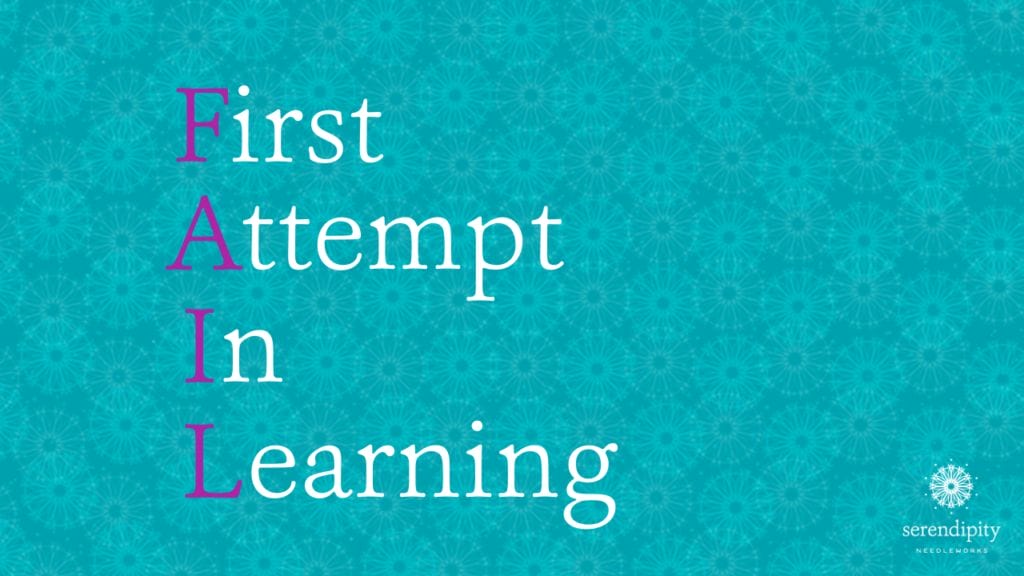In the spring of 2004, I attempted to write my very first stitch guide for a needlepoint canvas. If a stitch fit into an area, I stuck it there – and what I ended up with was a mishmash of canvas embroidery stitches that absolutely did NOT play well together. I was a complete and total failure! Or was I?
It was tough to admit, but I had to acknowledge that I didn’t know what I was doing. After struggling with my failure, I knew I couldn’t move on until I learned from the experience. And, now, I’m incredibly grateful that it happened. I learned some critical lessons and I’m certain that I wouldn’t be where I am today, as a stitcher, if I’d not botched that initial attempt.
Not every failure ends well, though. Sometimes, you may suffer a setback and, instead of plowing through, you throw up your hands in despair. I get it! I’ve been there, too. But I don’t think it has to be that way. In fact, I believe it’s all in how you process it. I’m convinced that, if you’re going to succeed at something, you have to learn to deal with failure.
So, how do you do that?
In my opinion, there are six critical factors to turning failures into stepping stones to success – including needlepoint success…
Acknowledge the failure.
It all starts right here! Failure is natural if you’re trying to achieve success with something that’s new to you. My failure with writing that first stitch guide would’ve been far more debilitating if I hadn’t acknowledged that I had a problem. Instead of denying the writing on the proverbial wall, I recognized that my attempt was awful. Truly awful. And when you accept failure, you take away its power. Then, you can begin to turn it into something positive. (And yes, the evidence is long gone. I stealthily deposited it into the Waste Management dumpster behind the original Serendipity Needleworks brick and mortar shop on University Boulevard.)
Take full responsibility.
It can be hard to do, but you won’t get anywhere if you blame others for your failure. If you project the responsibility onto someone else, then you’ll always be a victim. Why? Because you can’t control others. You can only control yourself. When you take responsibility for the failure and become fully accountable for it, though, you take back control. Suddenly you realize that you could’ve done things differently. You open the door to the possibility of creating a different outcome in the future. But that can only happen when you acknowledge your failure and truly own it.
Allow yourself to grieve the failure.
It’s okay to feel sad about your failure. It’s also critical to recognize that YOU aren’t a failure. You just failed at accomplishing something. There’s a reeaaalllly big difference between those two things! You are never a failure unless you quit trying. And I know you’re not a quitter. 🙂
Learn from the experience.
Every failure can be positive if you learn something from it. Truthfully, there are just some things you can’t (or won’t!) learn without failing. It sure would be nice if it were different, but it’s not. Failure can be a powerful teacher. And it’s pivotal to determine what you could have done differently – and will do differently next time. Rather than asking “What went wrong?”, try asking “What was missing?”. That’ll open the door to all kinds of possibilities in the future – and it always results in learning.
Change your behavior.
Winston Churchill once said, “Those who fail to learn from history are condemned to repeat it.” And it’s so very true. When you keep doing the same things over and over again – the things that lead to failure – you’ll continue to experience more failures. You must be willing to change your behavior.
Try, try again!
You cannot allow failure to hold you back. If you fall off the horse you have to get back on – right away! If you don’t, then, in your mind, your failure will become larger. And if you wait long enough, you might never climb back up into the saddle. Instead, put the past behind you and move forward!

Remember, you’re going to fail if you tackle meaningful goals, like learning to choose the best stitches and threads for your needlepoint projects. You have to be willing to make failure work for you, though. And when you do that, you’re planting the seeds for success.
My colossal needlepoint failure from 2004 was actually the best thing that could’ve happened to me.
It helped me see two things…
- I had a lot to learn about choosing the best stitches and threads for my needlepoint projects.
- I was not a failure. Instead, I failed at my first attempt to write a stitch guide.
So, the next time you’re ready to throw in the towel, remember me and my first stitch-guide-writing failure. Then, frog your goofs and ask yourself what you might do differently next time.
Until next time, happy stitching…
XOXO!

PS: Are you on our Serendipity Needleworks NeedleNotes list? That’s where we share tips, ideas, events, and cheer each other on and I’d love to have you join me, so click here to subscribe. I’ll see you there! 😉






